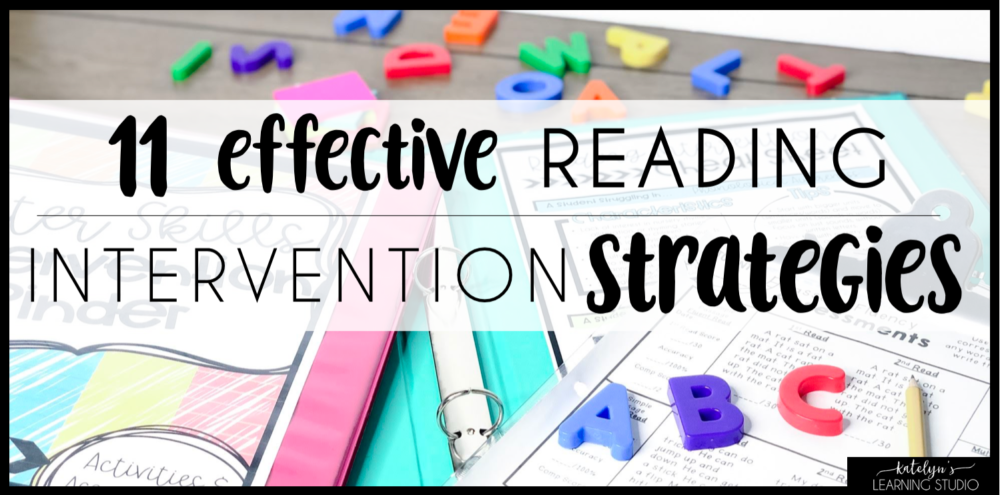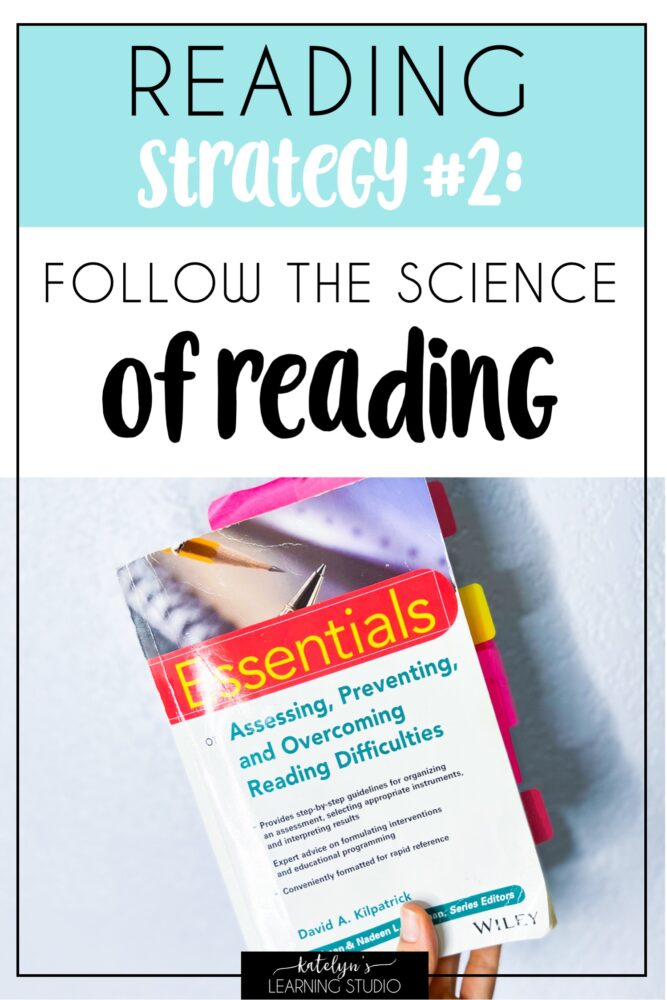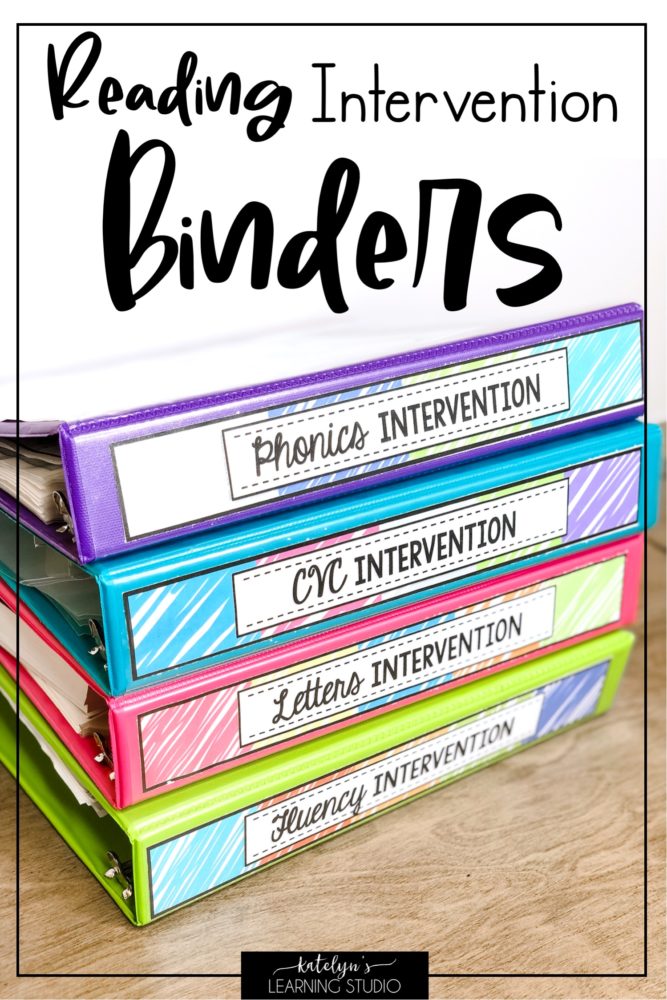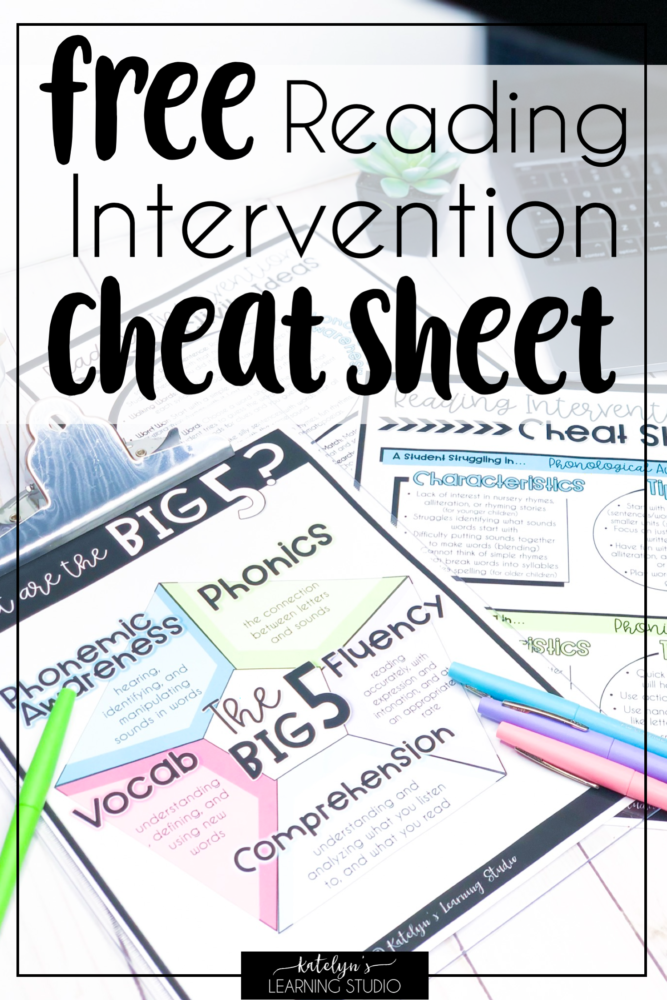Reading Intervention Strategies
Using effective reading intervention strategies is key when working with our struggling readers. It’s not only what we teach that matters; the way we teach it has a huge impact on student learning. Using reading intervention strategies that work can be the difference in helping your struggling readers learn to read.

Use this reading intervention strategies list to help plan your reading instruction.
Reading Intervention Ideas
If you are wanting to revamp your reading intervention plan, you are in the right place! I have a huge list of reading intervention strategies for you that will help you reach your struggling readers. They are all easy tips that you can easily implement now.
Also, if you need help identifying struggling readers, figuring out where they need help, and knowing how to help them, try downloading this FREE reading intervention cheat sheet that will make your reading intervention so much more effective.
The Big 5 Reading Skills
There are 5 main areas in reading that make up a well-rounded, solid reading foundation. Reading gurus refer to these areas as The Big 5 Reading Areas. Developing all 5 of these areas is crucial to student reading success. Below are some blog posts I’ve written with reading intervention strategies that specifically target each Big 5 Reading Area. Check them out for more specific ideas!
- Phonemic Awareness Intervention Strategies
- Phonics Intervention Strategies
- Fluency Intervention Strategies
- Reading Comprehension Intervention Strategies
- Vocabulary Intervention Strategies
Here is a video I made explaining the differences between the Big 5 Reading areas you can check out too:
General Reading Intervention Strategies
In the meantime, here are some SUPER valuable reading intervention strategies you can use to teach any reading subject. They are also great strategies for reading instruction for your whole class, or to help any student in reading. You can also check out my blog post about The Key to Stress Free Reading Intervention which gives several tips to ease your teacher stress.

11 reading intervention strategies to help you reach your struggling readers.
For specific activity ideas, you can use with your struggling readers, see this blog post with my Ultimate List of Reading Intervention Activities. There are tons of activities that appeal to all kinds of learners!
Reading Intervention Strategy #1: Read as much as possible!

One of the most important interventions for reading is simply reading.
A huge principle in building any skill, is you get better at what you practice. If you spend time practicing reading, guess what?! You will get better at reading! Other reading intervention activities absolutely have value and are important, but the #1 skill we are trying to build is reading text, so why not spend a lot of time reading?
The key here though is not to kill the love of reading. Let students read for fun, read with students, encourage reading at home, let students read during transitions and breaks, as a reward, or have class reading parties. Make it fun, and try to integrate it naturally as much as possible.
On a similar note…
People don’t realize how priceless read alouds are. It is such an amazing opportunity to show our students how to gain important reading skills!
Students learn a ton by example and modeling. When we read aloud any text (picture books, chapter books, reading passages, instructions, etc.), we have the chance to show students reading skills in action.
Reading out loud to students lets us model…
- sounding out tricky words
- reading with fluency
- thinking about what we read
- asking questions if we don’t understand
- using countless reading comprehension strategies.
Such a gold mine of opportunity! Here is a list of my favorite picture books and chapter books to read aloud to my class.
Reading Intervention Strategy #2: Follow the Science of Reading

Reading intervention is the most effective when you follow the Science of Reading. David Kilpatrick’s book Assessing, Preventing, and Overcoming Reading Difficulties is a great comprehensive explanation of the Science of Reading.
As a teacher, it’s important to learn HOW your students actually learn how to read. I promise, it will transform your teaching and you will no longer feel like you are spinning your wheels wondering if you are using the right strategies… because you will know the research and the science behind reading and understand what your students actually need!
As word of the Science of Reading spreads, information about it is getting more and more easily accessible–which is awesome! It’s also trending in schools all over and making a huge difference in how reading intervention is carried out. I’ll try to explain it as briefly as I can here, but don’t worry, I’ll give you some links to all the juicy details too!
What is the Science of Reading?
Students need…
- a STRONG foundation in phonemic awareness (read more about what phonemic awareness is here)
- letter knowledge (both letter names and sounds)
- phonics skills (here is a step by step guide on how to teach phonics)
- text they can DECODE
- time spent reading connected text (multiple sentences strung together in meaning)
It’s also very important to identify holes and gaps in student learning with a diagnostic assessment and to track student progress in these crucial areas (phonemic awareness and phonics) so you can tell which intervention strategies are working and when you need to re-adjust your strategies.
There is sooo much more to the Science of Reading, but that is it in a nutshell. I highly recommend hopping over to this blog post where I dive into deep detail about overcoming reading difficulties with the Science of Reading, and then this blog post where I introduce Orthographic Mapping: The Key to Learning to Read.
Reading Intervention Strategy #3: Mix it up with student choice and teacher assigned reading

You should use both teacher assigned and student choice texts in your reading instruction.
There is value in both student choice and teacher choice when it comes to reading, and there should definitely be both in good reading instruction.
Letting students choose their own books gives them independence and ownership of their reading. It increases motivation because they get to pick what they actually want to read. They can read about their interests, at levels they feel comfortable reading. Reading instruction without student choice will have a lot lower student engagement.
Teacher assigned text also has its place though. Students need variety in text types (books, passages, fiction, nonfiction, etc.) and they need to be reading at levels that are best for them. Teachers can help provide that guidance and give them the perfect match. When choosing teacher assigned texts, try to keep in mind student interests and find engaging texts if possible.
Reading Intervention Strategy #4: Use real books along with reading passages and textbooks
Reading passages and textbooks are great because they allow focused practice in the skills you are learning, at just the right level. They often come with comprehension questions and pre-designed activities that coordinate perfectly. I use them all the time, like these Animal Research Passages or these Snowflake Bentley Reading Passages.
However, real books are SO important to include in your instruction too. Students feel like real readers when they read real books, and their engagement is so much higher. It is a challenge to find a class set all in the same book, so one idea is to teach a general reading strategy, and then let students choose a book (it can be from a selection you provide) to practice it with.
Finding real books that are at an appropriate reading level AND interesting can be super hard. I am a book nerd though (and proudly so!), so I spent a ton of time making a list of my Top 91 Best Books for Beginning and Reluctant Readers! All of the books are high-interest and organized into levels so you can find the perfect fit!
Reading Intervention Strategy #5: Independent reading and Instructional reading level

One of the best reading strategies for students is to read at their right level.
What are the 3 reading levels?
There are 3 types of reading levels: independent reading level, instructional reading level, and frustrational reading level.
- Independent reading level is when a student is reading at 95-100% accuracy
- Instructional level is when a student is reading at 90-94% accuracy
- Frustrational level is when a student is reading at 89% accuracy or below
It’s important to help students find texts that are at the independent reading level when they are reading for fun on their own, and at the instructional level when they are reading with you or during a lesson.
The Independent reading level is where the love of reading is built, and the instructional reading level is where growth in reading skills happens. Avoid the frustrational reading level if possible, because that is where students develop anxiety, frustration, and an aversion to reading.
If you need some ideas for finding books at just the right level, here are some of my favorite book recommendations for students at each reading level.
Reading Intervention Strategy #6: Make every child feel successful

Don’t forget the importance of early intervention and staying positive.
When students feel defeated, their motivation plummets. When students feel successful, their motivation skyrockets. Who doesn’t want to keep doing what they feel really good at? It is so important to make sure each student experiences little successes every day in their reading, and to celebrate those successes with them.
Give them plenty of little successes to help them feel like they can succeed. Here are some ideas:
- Specific positive praise is a great and easy way to let students know they are succeeding.
- Break daunting assignments into smaller, easier tasks they can feel successful in as they complete.
- When doing activities together, start with easier tasks they can build confidence with from the start.
Reading Intervention Strategy #7: Break it into shorter chunks

Don’t overlook this tip on this reading intervention list.
Sometimes (maybe more than sometimes) students have a hard time staying focused during long lessons. I used to have a tendency to want to stretch lessons out and be as thorough as I possibly could while teaching, but I’ve learned that the longer a lesson goes, the more time I’m wasting because students are just not as engaged. If you have a large chunk of time for a lesson, try breaking it up into shorter chunks.
Here are some tips for breaking up your instruction block:
- change activities
- switch up the materials
- let students move to different spots
- do brain breaks to let students have a breather and then re-focus
If you need ideas on quick and easy reading intervention activities to break your time into, this list has a ton of ideas!
Reading Intervention Strategy #8: Rewards for effort and completion

This is one of the reading interventions strategies that will increase student motivation the most.
An intrinsic love of reading is the ultimate goal for all of our students, but sometimes rewards and incentives are just dang motivating. It’s crazy what lengths a student will go to, just to earn a little plastic dinosaur figure, but hey, it works! I use a lot of sticker charts, point systems, and prizes to help keep motivation up. However, what’s most important to me is that the student is still trying and putting in an effort, not necessarily that they are scoring perfect on everything.
I like to give rewards or incentives for effort and completion rather than for achievement. That doesn’t mean you can’t celebrate when students achieve well, but my focus is on students continuing to try instead of scoring perfectly. Rewards for completion also help stretch out engagement, because for each little activity they do, they are one step closer to a prize.
Reading Intervention Strategy #9: Routines

Use routines in your student reading interventions.
Students thrive on routine. They love knowing what’s coming and being able to participate smoothly in it. When they know exactly what they need to do each time, there will be less time lost in explaining directions and they will feel confident in knowing what they need to be doing. Instruction will be efficient, and student engagement will be up.
Here are some examples of Reading Intervention Routines:
- routines for the process of being called back
- completing the same warm-up activity each time (these intervention binders have great activities to use as warm-ups!)
- following the same lesson structure each time (for example: warm-up, phonics skill, passage, comprehension)
I talk more about making the most of your reading intervention time in this blog post if you need more tips for efficient and effective reading intervention and I give you some more routine ideas in this post about 5 Reading Intervention Tips to Make your Life Easier.
Reading Intervention Strategy #10: Games

Games make great reading intervention activities!
We already talked about rewards being super motivating, but we can’t forget competition! Even if you don’t make a big deal of winning and losing, or if it’s a game where everyone wins, the idea of playing a game is so engaging!
Games can be as simple as rolling a dice and moving a game piece along a board, or taking turns drawing game cards.
- You can have the game be separate from the skill, and let each student take a turn after they complete a skill (like tossing a bean bag, trashket-ball, or rolling a die)
- OR you can integrate skills into the game (like reading a word on a game card or having words on a game board)
Games are so effective, that I made sure each of my Reading Intervention Binders has an entire section devoted to fun games for reviewing and practicing skills! For holiday fun, I use these Halloween CVC Game Cards or these St. Patrick’s Day Board Games as great phonics practice. I love to play games during the holiday seasons as an educational “celebration”.
For some more ideas, you’ll love these 5 Super Fun Reading Games for Instant Engagement!
Reading Intervention Strategy #11: Direct Instruction

Use reading intervention strategies with explicit instruction.
When I was going through college, there was some controversy on direct instruction vs inquiry. Inquiry and discovery were all the rage, and it is AWESOME in the classroom! It gives so much student engagement and motivation. However, when working with struggling readers, it is not always the best way to go. In inquiry, students are guessing what they need to be learning, and struggling readers need to know from the start what their goal is. Struggling readers respond best to direct, explicit instruction.
Direct Instruction Cycle:
- teacher models the skill
- teacher and student do the skill together
- student practices that same skill on their own
You can refer to this cycle as “I do, We do, You do”. It is optimal for building confidence and focusing on exactly the skills students need to practice. You can repeat it as many times as you need to in a lesson. In fact, to keep an engaging pace, it’s best to go through many quick “I do, We do, You do” cycles in a lesson.
Ok, one more plug for my Reading Intervention Binders, but they really are the backbone of all the reading interventions that I teach! They are great for using this cycle. Each activity gives you several opportunities to practice a skill. You can model the first one, do one together, and let the student practice the rest of them independently.

Use these reading intervention strategies with these activity binders to make planning easy.
I hope this list of reading intervention strategies helps you transform your reading instruction into an effective and awesome success! If you need more tips for helping your struggling readers, download my FREE Reading Intervention Cheat Sheet which will help you figure out exactly who needs help, where they need it, and how to help them.
You can absolutely be a rockstar reading teacher, you can be the difference for your struggling readers! I believe in you!


